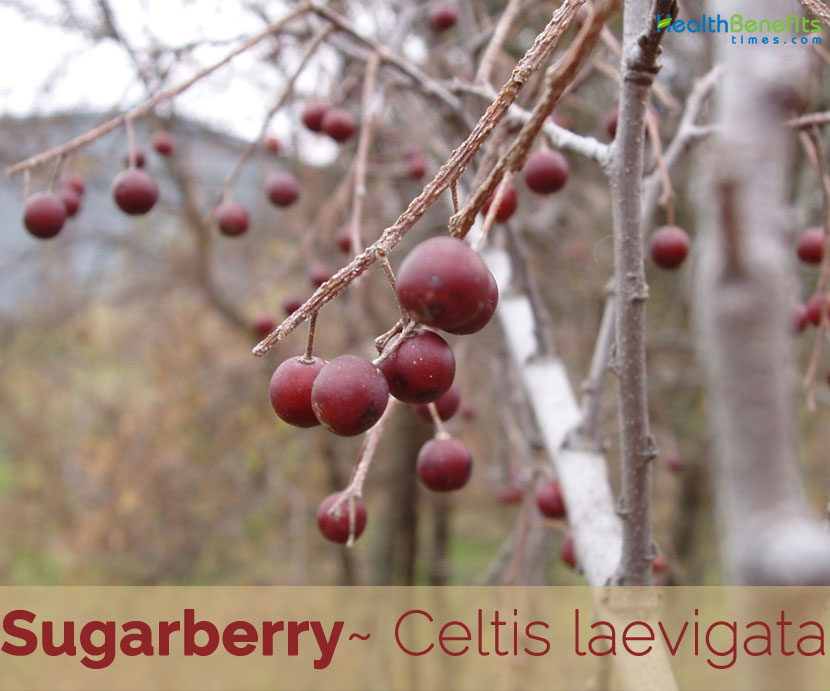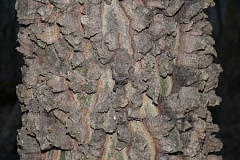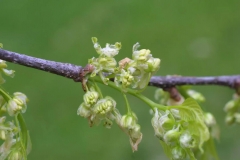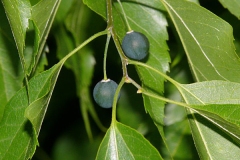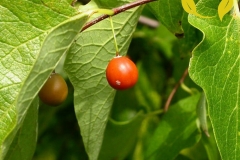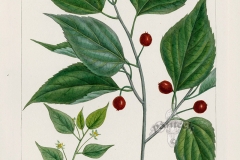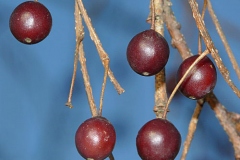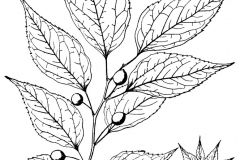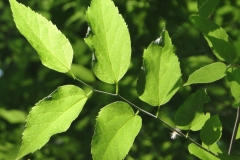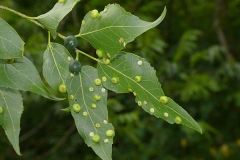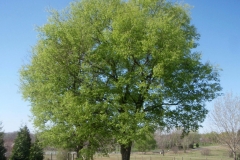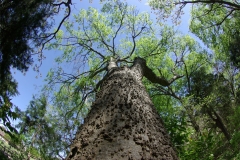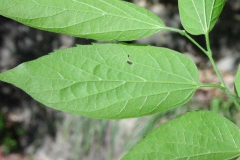Sugarberry, hackberry, lowland hackberry, sugar hackberry, Arizona sugarberry, netleaf hackberry, Small’s hackberry, southern hackberry, Texas sugarberry, Southern Hackberry, Lowland Hackberry, Hackberry, Palo Blanco, sugar hackberry, beaverwood and nettlewood are some of the popular common names of the plant. Genus name Celtis is the ancient Greek name for a lotus with sweet berries, and was used by Pliny. Specific epithet Laevigata means smooth, and most of the sugarberry’s bark is smooth but there are always tell-tale corky warts, without thorns. It is interesting that English speakers would refer to the tree as the Sugarberry and the Greeks, a world and language away, call their tree, the C. australis, the Honeyberry. Clearly the dry sweetness impresses people. The plant is harvested from the wild for mainly local use as a food, medicine and source of materials. It is grown as an ornamental and a street tree
Sugarberry Facts
| Sugarberry Quick Facts | |
|---|---|
| Name: | Sugarberry |
| Scientific Name: | Celtis laevigata |
| Origin | Southeastern part of the United States, ranging south from southeastern Virginia to southern Florida |
| Colors | Green berry turning to orange, red or dark purple as they matures |
| Shapes | Round fleshy berry-like drupes about 0.4–0.9 cm long |
| Health benefits | Beneficial for sore throats, venereal disease, heavy menstrual and inter-menstrual uterine bleeding, peptic ulcers, diarrhea, and dysentery |
| Name | Sugarberry |
|---|---|
| Scientific Name | Celtis laevigata |
| Native | Southeastern part of the United States, ranging south from southeastern Virginia to southern Florida; west to central Texas and including northeastern Mexico; north to western Oklahoma and southern Kansas; and east to Missouri, extreme southern Illinois, and Indiana. It occurs locally in Maryland |
| Common Names | Sugarberry, hackberry, lowland hackberry, sugar hackberry, Arizona sugarberry, netleaf hackberry, Small’s hackberry, southern hackberry, Texas sugarberry, Southern Hackberry, Lowland Hackberry, Hackberry, Palo Blanco, sugar hackberry, beaverwood, nettlewood |
| Name in Other Languages | Arabic: Mis naeim (ميس ناعم) English: Southern hackberry, Sugar hackberry, Sugarberry, Texan sugarberry, Netleaf hackberry, German: Glattblättriger Zürgelbaum Spanish: Palo blanco |
| Plant Growth Habit | Medium to moderately large-sized deciduous tree |
| Growing Climates | In rich bottomlands along streams, in flood plains, and on rocky slopes, generally in clay soils, streams and in woodlands |
| Soil | Succeeds in any reasonably good soil, preferring a good fertile well-drained loamy soil. Succeeds on dry gravels and on sandy soils. It cannot tolerate prolonged flooding or water-saturated soils |
| Plant Size | Up to 30 meters tall and cylindrical bole can be up to 100 cm in diameter |
| Root | Relatively shallow; it does not form a distinct taproot and has only average resistance to wind throw |
| Twigs | Twigs are slender, zigzagging, and greenish-brown to light reddish-brown. The pith is commonly chambered at the nodes and homogenous between the nodes |
| Bark | Bark of young trees is gray and smooth; mature trees develop corky outgrowths that are scattered to dense with smooth areas in between |
| Leaf | Alternate, typically small to medium sized (6–8 cm long), usually twice as long wide, with a long-pointed tip. Leaves are usually lanceolate, ovate or oval shaped, and often curve to one side. Leaf margins are mostly untoothed, but a few (rarely many) small teeth may be present |
| Flowering season | April |
| Flower | Small clusters, with functionally unisexual female and male flowers on the same tree, occasionally with male and females flowers combined. |
| Fruit Shape & Size | Round fleshy berry-like drupes about 0.4–0.9 cm long |
| Fruit Color | Green berry turning to orange, red or dark purple as they matures |
| Fruit Skin | Thick skin with netlike pattern on the surface |
| Wood | One round brown seed |
| Seed | One round brown seed |
| Plant Parts Used | Leaves, fruit |
| Propagation | By seed and cuttings |
| Lifespan | Over 150 years |
| Season | October |
Plant Description
Sugarberry is a medium to moderately large-sized deciduous tree growing up to 30 meters tall and cylindrical bole can be up to 100 cm in diameter. It has a straight, short bole and a broad, rounded, and open crown with spreading or slightly drooping branches. Roots are relatively shallow; it does not form a distinct taproot and has only average resistance to wind throw. The twigs are slender, zigzagging, and greenish-brown to light reddish-brown. The pith is commonly chambered at the nodes and homogenous between the nodes. Bark of young trees is gray and smooth while mature trees develop corky outgrowths that are scattered to dense with smooth areas in between.
Leaf scars are crescent-shaped or oval, bundle scars 3 per leaf scar, stipule scars are inconspicuous. Buds axillary, brown or reddish-brown, 1.5–3.2 mm long, ovoid, sharp, pubescent, puberulent, bud scales imbricate. The plant is found growing in rich bottom lands along streams, in flood plains, and on rocky slopes, generally in clay soils, streams and in woodlands. It succeeds in any reasonably good soil, preferring a good fertile well-drained loamy soil. Similarly it does best on dry gravels and on sandy soils. It cannot tolerate prolonged flooding or water-saturated soils. Sugarberry has a moderately long life span, not usually living over 150 years.
Leaves
Leaves are deciduous, simple, petiolate, alternate, distichous, about 6–8 cm long, 3–4 cm wide. Leaves are usually lanceolate, ovate or oval shaped, and often curve to one side. Leaf margins are mostly untoothed, but a few (rarely many) small teeth may be present. Leaf apices are acuminate or acute or caudate. Leaf bases are cuneate or oblique or obtuse or rounded. Leaves bear 3 prominent veins that branch from the base of the leaf blade. Upper surface of the leaves are green or yellow-green, glabrous or glabrate while lower surface are green or yellow-green, glabrous or glabrate. Light green leaves turn bright yellow in fall and can be showy in some years. Petioles are 0.6–1.3 cm long and glabrous. Stipules are present and are caducous.
| Leaf arrangement | Alternate |
| Leaf type | Simple |
| Leaf margin | Serrate |
| Leaf shape | Ovate, lanceolate |
| Leaf venation | Pinnate, brachidodrome, reticulate, bowed |
| Leaf type and persistence | Deciduous |
| Leaf blade length | 1 to 6 inches |
| Leaf color | Light green on top, paler green underneath |
| Fall color | Yellow |
| Fall characteristic | Showy |
Flowers & Fruit
Flowers occur in small clusters, with functionally unisexual female and male flowers on the same tree, occasionally with male and females flowers combined. Male flowers occur in clusters and female flowers are solitary. Greenish flowers appear in spring (April –May).
| Flower color | Greenish white |
| Flower characteristic | Not showy; emerges singly or in clusters at leaf axils |
| Flowering | Spring, with the leaves |
Fertile female flowers give way to an often abundant fruit crop of round fleshy berry-like drupes about 0.4–0.9 cm long. Fruits are initially green turning to orange, red or dark purple as they mature. Fruit has thick skin with netlike pattern on the surface. Each drupe has one round brown seed within. Fruits are attractive to a variety of wildlife. Birds consume the fruits and disperse the seeds. Fleshy parts of the fruit are edible and sweet.
| Fruit shape | Round |
| Fruit length | 1/3 inch |
| Fruit covering | Fleshy drupe |
| Fruit color | Orange to red, turns deep purple when ripe |
| Fruit characteristics
|
Attracts birds; not showy; fruit/leaves a litter problem |
| Fruiting | Matures in the fall |
History
Sugarberry ranges south from southeastern Virginia to southern Florida, west to central Texas and northeastern Mexico, and north to western Oklahoma, southern Kansas, Missouri, southern Illinois, southern Indiana, and western Kentucky. It is localized in Maryland, the Rio Grande Valley, and northeastern Mexico. Its range overlaps the southern part of the range of common hackberry.
Traditional uses and benefits of Sugarberry
- Decoction of the bark has been used in the treatment of sore throats.
- It has also been used, mixed with powdered shells, as a treatment for VD.
- The Houma used a concentrate made from the bark to treat sore throats.
- Decoction made from the bark and ground up shells to treat venereal disease.
- Due to their astringent properties, both the leaves and the fruit may be taken as a decoction to reduce heavy menstrual and inter-menstrual uterine bleeding.
- Fruit and leaves may also be used to astringe the mucous membranes of the gut in peptic ulcers, diarrhea, and dysentery.
Culinary Uses
- Fruit can be consumed raw or cooked.
- The Acoma, Navajo, and Tewa all consumed the berries for food.
- The berries of this species were used as a food seasoning by Native Americans and early settlers.
Other Facts
- This tree may be used as a lawn tree or street tree.
- Wood is used mostly for cheap furniture but also is used for dimension stock, flooring, crating, fuel, cooperage, and fence posts.
- The plant is harvested from the wild for mainly local use as a food, medicine and source of materials.
- The Navajo boiled the leaves and branches to make dark brown and red dye for wool.
- Sugarberry is used for furniture, athletic goods, firewood, and plywood.
- It is used as an ornamental and as a street tree in residential areas in the lower South.
- The berries secrete a sweet sticky substance in the autumn that attracts millions of mealy-bugs.
References:
https://www.itis.gov/servlet/SingleRpt/SingleRpt?search_topic=TSN&search_value=19042#null
https://npgsweb.ars-grin.gov/gringlobal/taxonomydetail.aspx?id=70160
https://pfaf.org/user/Plant.aspx?LatinName=Celtis+laevigata
https://www.missouribotanicalgarden.org/PlantFinder/PlantFinderDetails.aspx?kempercode=a857
https://plants.usda.gov/core/profile?symbol=CELA
https://www.fs.fed.us/database/feis/plants/tree/cellae/all.html
https://en.wikipedia.org/wiki/Celtis_laevigata
https://edis.ifas.ufl.edu/st138
http://www.narc.gov.jo/gringlobal/taxonomydetail.aspx?id=70160
http://www.ibiblio.org/openkey/intkey/web/CELA.htm
http://www.theplantlist.org/tpl1.1/record/kew-2708323
http://temperate.theferns.info/plant/Celtis+laevigata
https://gd.eppo.int/taxon/CETLE
https://plants.usda.gov/factsheet/pdf/fs_cela.pdf
https://www.mortonarb.org/trees-plants/tree-plant-descriptions/sugarberry
https://www.cabi.org/isc/datasheet/12410


